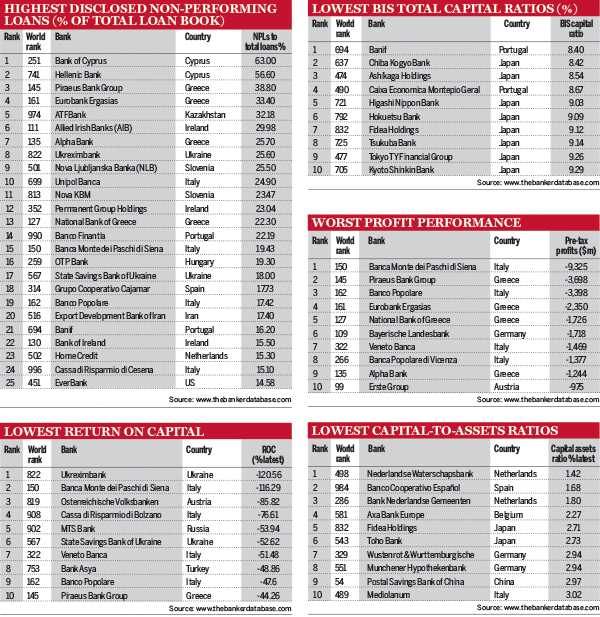European lenders perform poorly by nearly every measure used to assess asset quality in the 2015 Top 1000 World Banks ranking. The only criterion where they do not hold the majority among the worst performers is total capital ratio – Japanese lenders hold sway by that measure. Nonetheless, as poor asset quality was also a problem for European lenders in last year’s ranking, on the whole there has been noticeable improvement across all criteria.
With regards to asset quality, the situation worsened for Cypriot and Greek banks, but largely improved in the rest of the eurozone. While the stock of non-performing loans (NPLs) decreased at other troubled European institutions, such as Allied Irish Banks, where the NPL ratio dropped nearly six percentage points to 29.98%, it soared at Bank of Cyprus, bringing its ratio to 63%, the highest in the Top 1000. Another Cypriot institution, Hellenic Bank, follows in second position, with 56.6% of its loans in arrears. NPLs at Greece’s banks have also risen, to as high as 38.8% for the Piraeus Bank Group. As was the case in the 2014 Top 1000 World Banks ranking, all of the big four Greek banks – Piraeus, Eurobank Ergasias, Alpha Bank and National Bank of Greece – are featured in the top 25 for NPLs.
Greece’s big four also record some of the largest losses in this year’s Top 1000; Piraeus has lost $3.7bn, Eurobank Ergasias $2.35bn, National Bank of Greece $1.73bn and Alpha Bank $1.24bn, bringing the total losses for the group to $9.02bn. However, as was the case in last year's ranking, the largest loss has taken place at an Italian bank – Monte dei Paschi. This is hardly surprising given that nine Italian institutions failed the stress test carried out by the European Central Bank in November 2014, with Monte dei Paschi faring the worst.
While the $9.33bn loss at Monte dei Paschi is not as dramatic as UniCredit's loss of $22.03bn in 2013, as reported in the 2014 ranking, it is demonstrative of the troubling combination of a dragging economy and high NPLs that continue to weigh down Italian lenders. Three other Italian banks are also included among the 10 worst losses, with Banco Popolare posting a $3.4bn loss and Veneto Banca and Banca Popolare di Vicenza losing $1.47bn and $1.38bn, respectively. The list of worst performers closes with Erste Bank, which posted a loss of $975m due to its problems with non-performing debt in Romania and forced foreign exchange loan conversions in Hungary.
Outside the eurozone, Ukrainian Ukreximbank is the largest loser globally by return on capital, achieving a -120.56% return. Another state-owned Ukrainian lender, State Savings Bank of Ukraine, follows in sixth spot having posted a -52.62% return. Monte dei Paschi ranks second, with a return of -116.29%, while Osterreichische Volksbanken is in third position; the bank is now in the process of winding down by the end of 2015.
In general, capitalisation was not a problem for European banks, with the exception of two Portuguese banks. At 8.4%, Banif has the lowest capital ratio in this year’s Top 1000 and a local rival, Caixa Economica Montepio Geral, is not much better capitalised – with a BIS capital ratio of 8.67%. However, it is the Japanese banks that have a low capital ratio as part of their business model. This is especially the case for smaller Japanese lenders, who dominate the capital ratios table; notably, both Chiba Kogyo Bank and Ashikaga Holdings have ratios below 9%.
Similar to last year's ranking, the list of most leveraged banks is dominated by highly specialised banks, such as savings banks Banco Cooperativo Español and Postal Savings Bank of China, where asset volatility is so minimal that high leverage does not automatically put the bank at risk. Other banks, such as Dutch Nederlandse Waterschapsbank and Bank Nederlandse Gemeenten, provide financial services for the public sector and others, such as Axa Bank Europe, complement their group’s insurance services.





